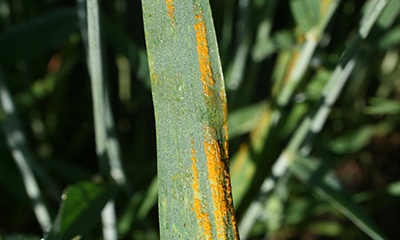September 20, 2016

Wheat stripe rust was the premier yield-reducing factor on many Michigan farms this year. With fall planting just around the corner, now is the time for growers to review how the disease develops, how to manage it and what to do this fall, according to Michigan State University Extension.

What to consider when managing fall wheat stripe
Stripe rust is caused by the fungus Puccinia striiformis f. sp. tritici. A total of 109 races of P. striiformis f. sp. tritici have been found in the U.S., according to “Epidemiology and control of stripe rust [Puccinia striiformis f.sp. tritici] on wheat,” a study published in the Canadian Journal of Plant Pathology by X.M. Chen. Yield losses of 40% or more in fields where susceptible varieties are planted can occur.
Infection
To date, the stripe rust fungus has not been known to overwinter in Michigan. Mild winters (in the south where it overwinters) and cool, wet summers increase the likelihood of infection. Urediniospores are blown into Michigan on wind currents from the south. Once spores get here, they need proper moisture, temperature and a susceptible wheat crop for infection to occur. Disease development is most rapid between 50 and 59 degrees Fahrenheit with intermittent rain, but spores can survive from 32 to 77 F.
Spores land on a leaf surface, germinate and infect through natural plant openings called stomata. Several hours of moisture on leaves are required for the spores to germinate and infect a leaf. Once inside the leaf, the fungus reproduces and eventually erupts through the leaf surface in a mass of orange urediniospores. The pathogen has a latency of 11-14 days, meaning visible signs of the pathogen don’t show up right away, making scouting a little bit more difficult.
Fall management
While infections in the fall are possible, conditions are usually not very favorable for a serious infestation. For most of Michigan, wheat is planted late enough that the temperatures fall below optimum for infection within a couple weeks after planting
Volunteer wheat can serve as a green bridge and a source of inoculum this fall. Volunteer wheat can also harbor other diseases such as wheat streak mosaic virus, which is spread by the wheat curl mite. It is a good idea to control volunteer wheat as soon as possible after harvest rather than wait until next spring, MSU advises.
One of the biggest questions posed is, “Can I save seed from a field that was infected this year to plant this fall?” The answer is yes – as long as it is not patent protected. Stripe rust primarily infects the leaves. Rarely does it infect the spike. Even if it does infect the spike, it does not infect the kernels. It is always a good idea to clean and treat seed before planting. It is especially important if you have potential inoculum sources nearby the field you are planting. Seed treatment can delay the onset of the disease on seedlings. The epidemic levels of stripe rust in Michigan during 2016 were unusually high. It is hard to predict the likelihood of this happening again.
Selecting varieties with resistance to stripe rust is the most important management tool. While you should never select varieties solely on their level of stripe rust resistance, it can help you to manage the disease on your farm. The primary and secondary factors when selecting varieties remain yield and fusarium head blight, respectively. Stripe rust can be managed effectively with fungicides. If you prefer not to use fungicides, select varieties with resistance.
Pennington writes for MSU Extension
You May Also Like




